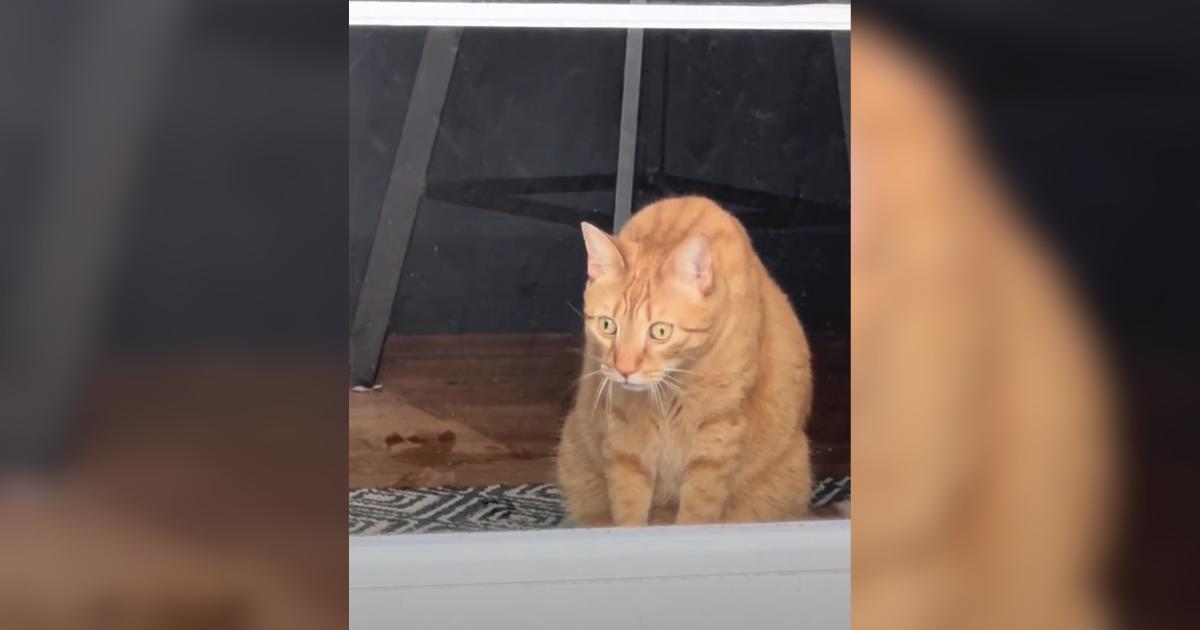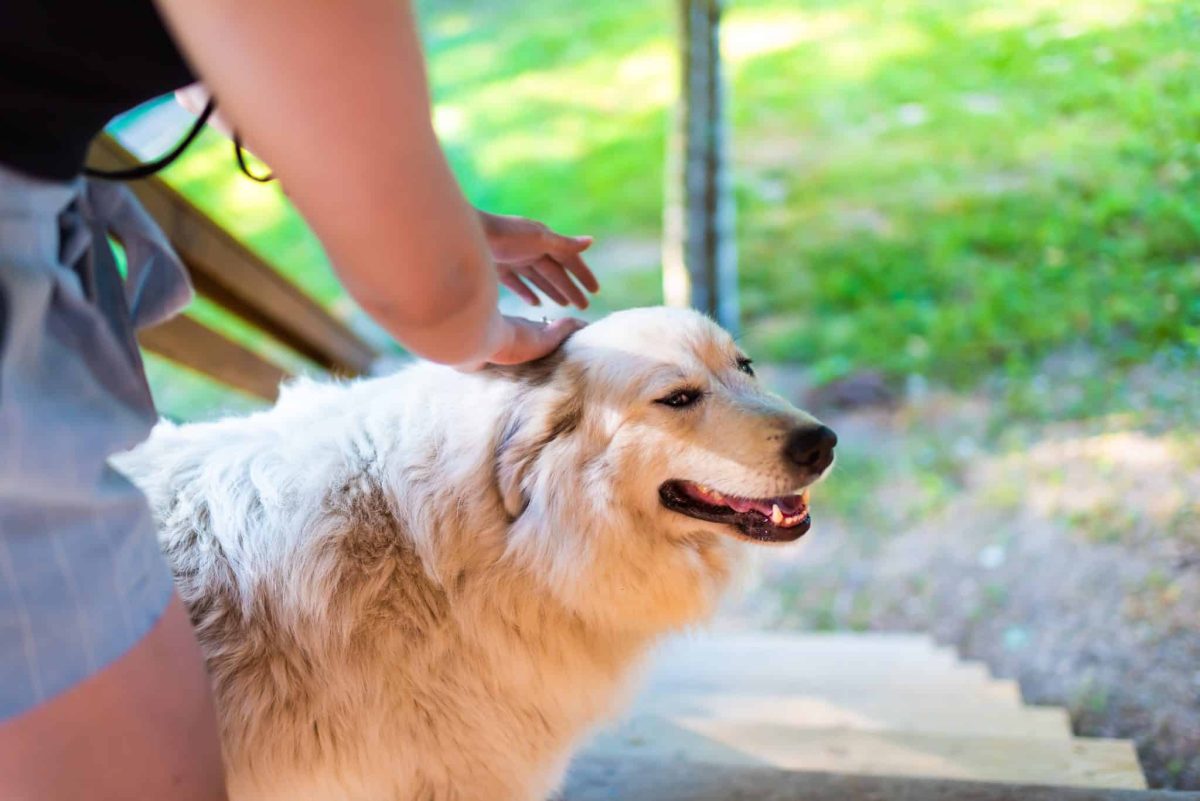I’m looking forward to giving a talk in Madison on April 5th about comparisons between dogs and wolves (alongside a much-anticipated talk about wolves in Wisconsin by expert Adrian Wydeven). The photograph above came to mind while I was thinking about what to say.
That’s me and Ayla at Wolf Park in Indiana. It’s pretty clear I was in rapture about being next to a wolf. It’s also pretty clear, based on her eyes and posture, that I was not sitting next to a golden retriever. Before I was given permission to enter her wolf pen, I was told “absolutely don’t look her in the eye, and if she nips at your pants, immediately push her head away.” (The instructions were more detailed, but not relevant here.)
I did not do that. I felt a light touch on my leg, and while deciding—was that a nip? should I do something?—the keeper instantly swept in and did what she’d suggested. But why was the caretaker so concerned about the wolves’ reaction? Wolves, after all, are our dog’s closest living relatives, sharing so much of their behavior with dogs. Wolves, like dogs, are uber social, remarkably so—so much so that they will feed and care for the young of others, rare in the world of mammals. They are exceptionally family oriented, they hunt together strategically, and they are super playful as adults, also rare in the animal world.
But here’s the thing: If you came over to visit, Skip would jump up on the couch and cuddle with you. (Especially if you were a woman; he’s a player) Ayla, however, was clearly not cuddly. If, however, I owned a wolf myself who I myself could cuddle with, I’d never let a visitor together on the couch with him. I’d put Wolfy away and keep you apart.
The similarities between dogs and wolves may be deep, but so are the differences, a reaction to strangers being one of the most obvious. Of course, many of these differences are because of “artificial selection.” (I dislike that term—humans are animals, not artificial Christmas trees.) But how is it that we ended up with the extreme variety of shapes and sizes we have now in the domestic dog? We’ve had plenty of time to create vastly different morphologes of cats, yet the physical variations in cats pale compares to dogs.
You can see this in the development of the cranial bones, for example, of dogs and cats. Puppies and dogs have very different cranial bone ratios (just think of the face of a puppy vs the face of a full-grown greyhound). Cats, on the other hand, have pretty much the same ratios from when they’re born to when they’re fully grown. This is a good thing: Imagine if a shelter had to deal with cats who sizes varied as much as a Mastiff and a chihuahua?
Okay, so genetics gave us a lot to play with when we first started having an effect on the genetics of Canis lupus. (This is not to diminish the effect of wolves’ own behavior—ie, the more docile possibly more likely to hang around humans.) But again, there’s that wolf on the couch thing.
Of course, there’s been a lot of” artificial selection,” for docility, although a certain amount that probably happened organically. We know that docility is a heritable trait—look at the work of Belyayev & Trut, who bred fur foxes for docility and ended up in just a few generations with foxes who wagged their tails, and greeted strangers enthusiastically, instead of hiding in the back or snarling and biting. (Note that some have challenged his hypothesis of the “domestication syndrome,” but the heritability of docility seems robust.)
But there’s more to it than that. In 2017 VonHoldt et al, curious why dogs are so much friendlier than wolves with the same developmental experience with people, published a study that found, in dogs only, mutations on Chromosome 7, similar to the ones in humans that lead to Williams-Beuren syndrome. These mutations cause, along with some physical changes, “hyper-sociability,” in that individuals exhibit extreme trust and affection toward strangers. I met a girl with this syndrome, and before knowing the above, we called her, lovingly, a human golden retriever.
Thanks to an increase in research on canine behavior in the last few decades (YAY!), there are some other fascinating differences that we’ve discovered between dogs and wolves. Here’s another one of the many things I’ll talk about on April 5: (Just fyi, seating is limited and ticket sales close March 25–just don’t want you to get left out if you want to come.)
It’s about eye contact. When and for how long we meet the gaze of others is critical in our own relationships, both human and canine. Think of how often you look at your dog, and your dog looks at you. It turns out that dogs initiate eye contact with people far more often than do wolves. (When I make these comparisons, it’s always between dogs and wolves raised in the same circumstances with the same amount of contact with people.) One study compared wolves, Australian dingoes—believed to be midway between wolves and dogs in term of domestication, and dog, and found that dogs initiated eye contact with people most, wolves the least, and dingoes in between. But perhaps my favorite study found this:
Mutual gazing had a profound effect on both the dogs and their owners. Of the duos that had spent the greatest amount of time looking into each other’s eyes, both male and female dogs experienced a 130% rise in oxytocin levels, and both male and female owners a 300% increase. From the article:
Mutual gazing had a profound effect on both the dogs and their owners. Of the duos that had spent the greatest amount of time looking into each other’s eyes, both male and female dogs experienced a 130% rise in oxytocin levels, and both male and female owners a 300% increase. (Kikusui was one of them, participating in the experiment himself with his two standard poodles, Anita and Jasmine.) The scientists saw no oxytocin increase in the dogs and owners who had spent little time gazing at each other, or in any of the wolf-owner duos.
In a second experiment, the team repeated the same essential procedure, except this time they gave the dogs a nasal spray of oxytocin before they interacted with their owners. There were also no wolves this time around. “It would be very, very dangerous to give a nasal spray to a wolf,” Kikusui laughs. Female dogs given the nasal spray spent 150% more time gazing into the eyes of their owners, who in turn saw a 300% spike in their oxytocin levels. No effect was seen in male dogs or in dogs given a nasal spray that contained only saline.
Nagasawa et al, Science 2015
It has been speculated that this oxytocin feed-back loop, the same as seen between mothers and babies, may explain much of our profound bond with dogs:
“I definitely think oxytocin was involved in domestication,” says Jessica Oliva, a Ph.D. student at Monash University in Melbourne, Australia, whose work recently showed that the hormone enhances the ability of dogs to understand human pointing. Still, she says, mutual gazing doesn’t happen in a vacuum; most of these dogs probably associate the behavior with food and playing, both of which can also boost oxytocin levels. So although we may view our dogs as our babies, they don’t necessarily view us as their mothers. We may just be cool friends who give them an occasional massage.”
Fun stuff, hey? If any of you have direct experience with wolf versus dog behavior, jump in! I can’t wait to hear more. And if you’re in the Madison area on April 5th and come to the talk, come up and say hi!
MEANWHILE, back on the farm: Here, to me, is a the perfect image symbolizing this time of year. Winter is dying out, spring is spring.
But wait, there are flowers outside too–check out these tiny snow drop buds in a sunny garden by the house:
Nonetheless, it’s still a sea of brown and grey here. We missed the huge storms sweeping the country (needed the rain but not all the destruction), so the mud is gone, but far too early for any color. (I usually call this time of year March Mudness.)
I had planned to get some photos of Maggie and Skip playing Keep Away with their favorite toy, but Maggie demurred and decided to pee instead. Very atypical. When she walked away from the toy with a slight limp it became clear. Something hurts, so no play. Wise girl my Maggie. (Who turned 12 a few weeks ago!) Paws crossed it’s minor.
Here’s to you, friends. May you only drop your toy when you pee because you’re busy enough as it is.






















 English (US) ·
English (US) ·